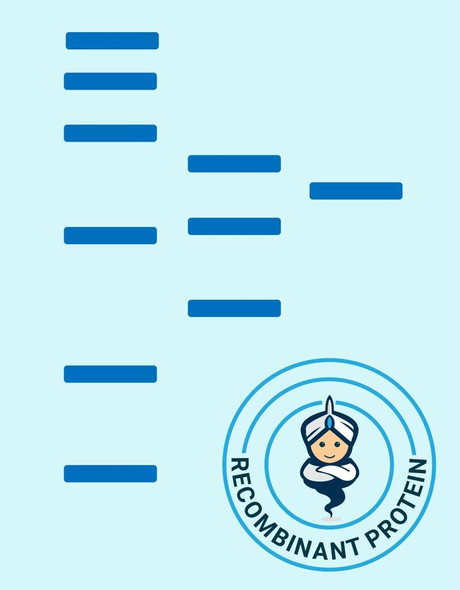Hormones Recombinant Proteins
Human STC 1 Recombinant Protein (RPPB5757)
- SKU:
- RPPB5757
- Product Type:
- Recombinant Protein
- Species:
- Human
- Uniprot:
- P52823
- Research Area:
- Hormones
Description
| Product Name: | Human STC 1 Recombinant Protein |
| Product Code: | RPPB5757 |
| Size: | 10µg |
| Species: | Human |
| Target: | STC 1 |
| Synonyms: | Stanniocalcin-1, STC, STC-1. |
| Source: | 293 cell line (Human embryonic kidney) |
| Physical Appearance: | White lyophilized (freeze-dried) powder. |
| Formulation: | Filtered (0.4�m) and lyophilized in 0.5mg/ml in 20mM Tris buffer, 50mM NaCl, pH 7.5. |
| Solubility: | Add deionized water to a working concentration approximately 0.5mg/ml and let the lyophilized pellet dissolve completely. Product is not sterile! Please filter the product by appropriate sterile filter before using it in the cell culture. |
| Stability: | Lyophilized STC-1 although stable at room temperature for 3 weeks, should be stored desiccated below -18°C. Upon reconstitution Stanniocalcin should be stored at 4°C between 2-7 days and for future use below -18°C.For long term storage it is recommended to add a carrier protein (0.1% HSA or BSA).Please prevent freeze-thaw cycles. |
| Purity: | Greater than 95.0% as determined by SDS-PAGE. |
| Amino Acid Sequence: | THEAEQNDSV SPRKSRVAAQ NSAEVVRCLN SALQVGCGAF ACLENSTCDT DGMYDICKSF LYSAAKFDTQ GKAFVKESLK CIANGVTSKV FLAIRRCSTF QRMIAEVQEE CYSKLNVCSI AKRNPEAITE VVQLPNHFSN RYYNRLVRSL LECDEDTVST IRDSLMEKIG PNMASLFHIL QTDHCAQTHP RADFNRRRTN EPQKLKVLLR NLRGEEDSPS HIKRTSHESA ASDYKDDDDK |
Stanniocalcin 1 (STC1) is the mammalian homologue of STC, which was originally identified as a calcium/phosphate-regulating hormone in bony fishes. In contrast, STC1 may play an autocrine and paracrine role with pleiotropic effects in mammals. It is expressed in a wide variety of tissues, but unexpectedly is not detected in the circulation under normal circumstances, which is possibly caused by its attaching to soluble and tethered forms of a high-affinity binding protein. STC-1 can affect calcium homeostasis, bone and muscle mass and structure, and angiogenesis through effects on osteoblasts, osteoclasts, myoblasts/myocytes, and endothelial cells in mouse model. Differential regulation of myocardial STC1 protein expression was reported in heart failure. In addition, STC1 may regulate calcium currents in cardiomyocytes and may contribute to the alterations in calcium homeostasis of the failing heart. STC1 was found to be a selective modulator of hepatocyte growth factor (HGF)-induced endothelial migration and morphogenesis, an inhibitor of macrophage chemotaxis and chemokinesis, suppressor of progesterone and luteinization inhibitor. Together with STC-2, it may play important roles in the processes of implantation and decidualization in the rat. In terminally differentiated adipocytes, it may function as a "survival factor", which contributes to the maintenance of the integrity of mature adipose tissue. In context with its possible role in gestation, a Big STC, a three highermolecular- mass variant has been described. STC1 was identified as one of hypoxia-responsive genes coupled to hypoxia-driven angiogenesis.Current research indicates that STC-1 might be a useful molecular marker to detect tumor cells in blood and bone marrow from patients with various types of malignancies.
Stanniocalcin-1 Human Recombinant produced in 293 cell line is a single, glycosylated, polypeptide chain containing 240 amino acids and having a total molecular mass of 25.9 kDa. The Stanniocalcin contains two extra residues which were used as a spacer and 8 residues form the C-Terminal Flag- tag.Stanniocalcin is purified by proprietary chromatographic techniques.The amino acid sequence of the recombinant human Stanniocalcin-1 is 100% homologous to the amino acid sequence AA 18-247 of the human mature Human Stanniocalcin-1.
| UniProt Protein Function: | STC1: Stimulates renal phosphate reabsorption, and could therefore prevent hypercalcemia. Belongs to the stanniocalcin family. |
| UniProt Protein Details: | Protein type:Secreted, signal peptide; Secreted Chromosomal Location of Human Ortholog: 8p21.2 Cellular Component: extracellular space; cytoplasm; apical plasma membrane; nucleus Molecular Function:hormone activity Biological Process: cellular calcium ion homeostasis; negative regulation of calcium ion transport; ossification; response to vitamin D; endothelial cell morphogenesis; decidualization; negative regulation of cell migration; embryo implantation |
| NCBI Summary: | This gene encodes a secreted, homodimeric glycoprotein that is expressed in a wide variety of tissues and may have autocrine or paracrine functions. The gene contains a 5' UTR rich in CAG trinucleotide repeats. The encoded protein contains 11 conserved cysteine residues and is phosphorylated by protein kinase C exclusively on its serine residues. The protein may play a role in the regulation of renal and intestinal calcium and phosphate transport, cell metabolism, or cellular calcium/phosphate homeostasis. Overexpression of human stanniocalcin 1 in mice produces high serum phosphate levels, dwarfism, and increased metabolic rate. This gene has altered expression in hepatocellular, ovarian, and breast cancers. [provided by RefSeq, Jul 2008] |
| UniProt Code: | P52823 |
| NCBI GenInfo Identifier: | 1706175 |
| NCBI Gene ID: | 6781 |
| NCBI Accession: | P52823.1 |
| UniProt Secondary Accession: | P52823,Q71UE5, |
| UniProt Related Accession: | P52823 |
| Molecular Weight: | |
| NCBI Full Name: | Stanniocalcin-1 |
| NCBI Synonym Full Names: | stanniocalcin 1 |
| NCBI Official Symbol: | STC1�� |
| NCBI Official Synonym Symbols: | STC�� |
| NCBI Protein Information: | stanniocalcin-1 |
| UniProt Protein Name: | Stanniocalcin-1 |
| Protein Family: | Stanniocalcin |
| UniProt Gene Name: | STC1�� |
| UniProt Entry Name: | STC1_HUMAN |






